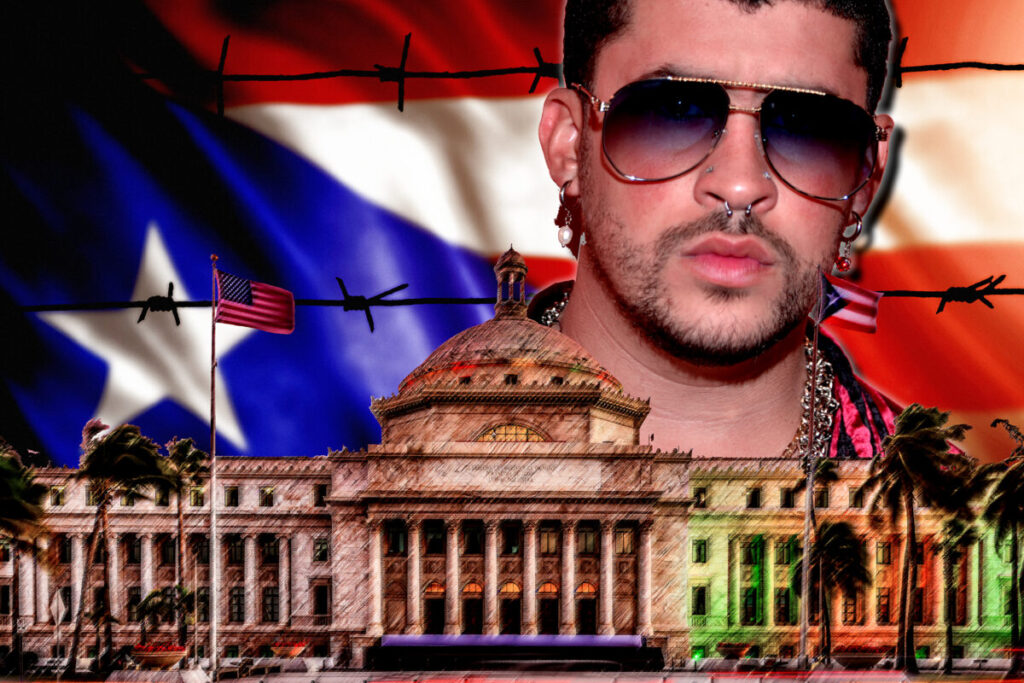By Lori Lee
NDG Contributing Writer
After quickly growing into an urban music sensation, Bad Bunny has taken on a global platform, as he agrees to sing in the Super Bowl Halftime show next February.
His cutesy name, stemming from a childhood photo donning a bunny costume, hides an oddly serious side of an extremely talented artist. Bad Bunny breaks every rule, combining elements of soul, punk, rock, and salsa, as he refuses to sing in English. Challenging his audiences to learn Spanish, he dedicates himself to his home of Puerto Rico.
Before Bad Bunny came Jose Feliciano, also from Puerto Rico, who sang his own bluesy rendition of the national anthem during the 1968 World Series. As he expressed his appreciation for his country, Feliciano received booing and backlash, some radio stations even blacklisting his work.
Now, at a time when anti-Hispanic sentiment has been very loud, Bad Bunny’s performance is already receiving backlash, said Antonio Mejías-Rentas, managing editor at Boyle Heights Beat, at an October American Community Media briefing. His assertion to do it in Spanish during the campaign to expel undocumented immigrants gives rise to FCC complaints even prior to halftime, added award -winning filmmaker, writer, and scholar, Frances Negrón-Muntaner, who also spoke at the briefing.

During the 80s and 90s, the way to crossover into the American mainstream was to record in English, said the former entertainment editor at La Opinión Mejías-Rentas. Julio Iglesias of Spain started a crossover in 1984, sharing duets with American stars, which helped to establish him in the U.S. Yet, Selena of Texas, after recording mainly in Spanish, was just starting her crossover album in ‘95, when tragically her family and EMI Records were forced to release a mixed language album posthumously after her death.
Recording in English is not necessary anymore, said Mejías-Rentas. Bad Bunny is using the Spanish language as a tool of resistance, interesting, considering the Supreme Court recently approved use of the language by U.S. Immigration and Customs Enforcement (ICE) to identify those who are undocumented.
Negrón-Muntaner noted, Bad Bunny’s success is part of a long history and demographic changes as youth, important to advertisers, have grown increasingly Latino, and as migrations of Spanish speakers grow elsewhere in the world. This is also happening due to changes in technology and the new ease with which artists can communicate with their audiences.
“They have become a lot more savvy, so they amass a certain type of economic power, and as a brand, they have more agency than prior generations,” added Negrón-Muntaner. In the long history of struggling to get heard, it seems cultural capital is shifting, she said. While art previously came out of New York or Hollywood, you can now have a superstar out of any number of places.
Bad Bunny comes from a place that sits culturally at a crossroads, its people exposed to the world in a particular way, said Negrón-Muntaner. It may seem interesting that a song in Spanish about belonging can resonate in countries where few even speak Spanish. Yet, Bunny’s social commentary on issues like the cost of living, forced migration, and the LGBTQ community, amplify how people are feeling as the same tensions happen elsewhere in the world.
“Because neoliberal capitalism is taking over the entire housing stock, the feeling of forced migration is actually resonating worldwide,” she added.
Predictions of U.S. Latinos becoming a powerful number have finally come true, added Julio Ricardo Varela, senior producer and strategist for D.C.-based Free Press. Bad Bunny is indeed a product of the current prominence of social and digital media, alongside the strong reaction against him, which, in itself, makes him powerful.
There are rumors of a petition to remove him from the lineup in order to honor only American artists, this though Bad Bunny is an American citizen from Puerto Rico. Despite the effort, Varela explained the NFL wants to make money and thus needs to diversify its audiences. “I don’t see a lot of questions about when Kendrick Lamar was here last year, he said. It comes down to mostly white owners who want to make billions of dollars and want to associate themselves with the best global brand in music right now.” They need global audiences because they want to be a global sports league on the same level as the Premier League and the World Cup, he iterated.
Though Puerto Ricans are not immigrants, Bad Bunny resists anti immigrant sentiment, in a German magazine responding he’s not having concerts stateside in the U.S. because he doesn’t want ICE at his concerts, explained Varela. This, though he chose to do his residency in Puerto Rico for other reasons, said Mejías-Rentas, including a desire to help the local economy and to bring attention to Puerto Rico. He is most seen as an advocate for Puerto Rican identity and nationality, said Mejías-Rentas.
Puerto Ricans hold the second largest Latino population in the United States, he added, as most Puerto Ricans live in the continental U.S. Yet, advocates of Puerto Rican independence, say Puerto Rico is really just a colony, citizenship being imposed on it by invasion in 1898.
Awareness about Puerto Rico has increased dramatically since Hurricane Maria, added Negrón-Muntaner, when Trump, who was President at the time, was widely criticized for his response to the crisis. With much of the coverage being too focused on the hypercritical, she commented, the coverage should have dived deeper into Puerto Rican experience.
With its own constitution, yet as a U.S. territory, Puerto Rico is neither a state nor a nation, its citizens lacking the right to vote, yet serving in all U.S. wars.
“There are nation-states that have multiple national groups within, said Negrón-Muntaner. The nationality of Puerto Ricans is the product of imagining ourselves as part of a national community, whether we have a state or not. … How is it that culture plays a role in a group imagining themselves as cohesive, as a nation, as an ethnic group, as a group with a shared past, a present, and a desire for a shared future?” she asked.




